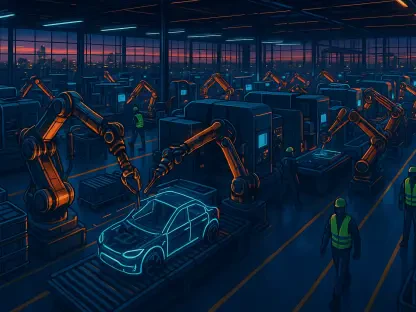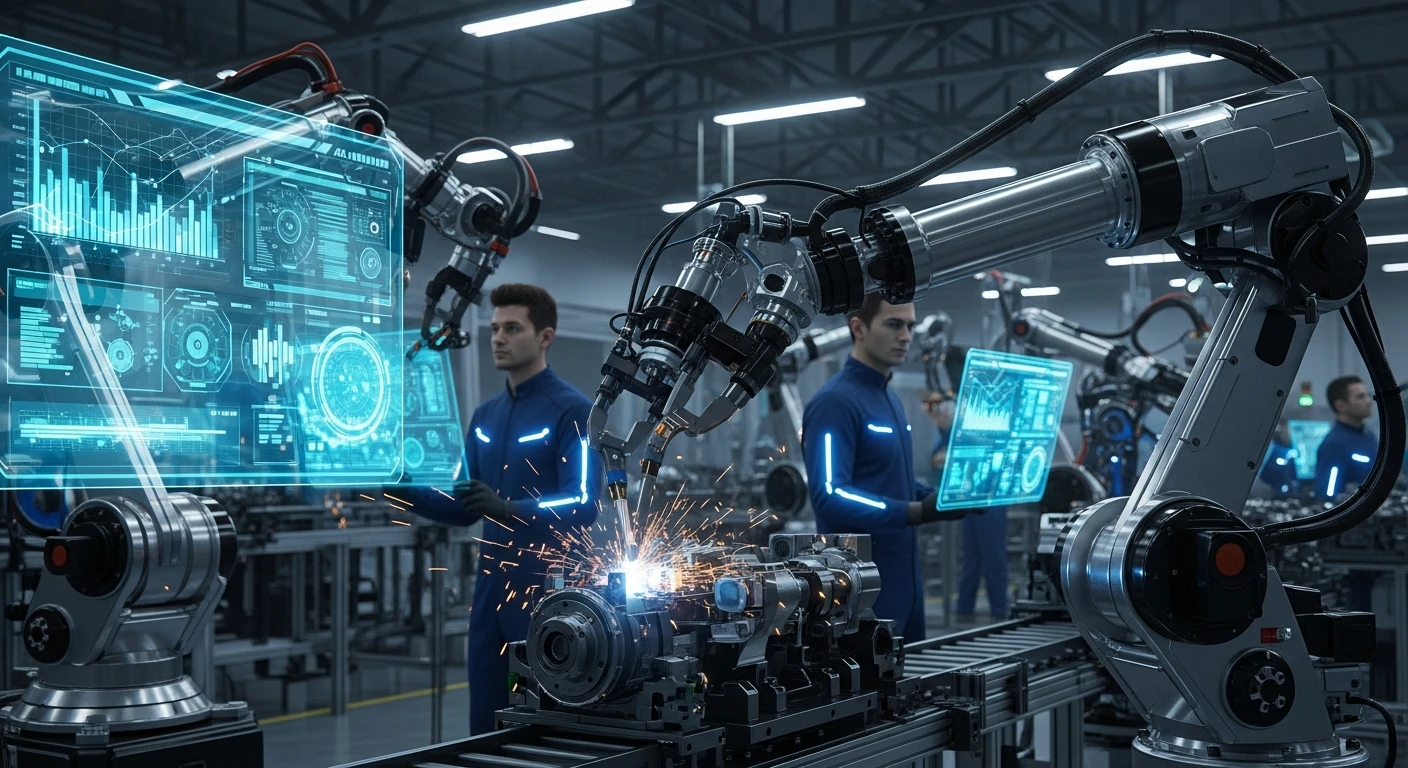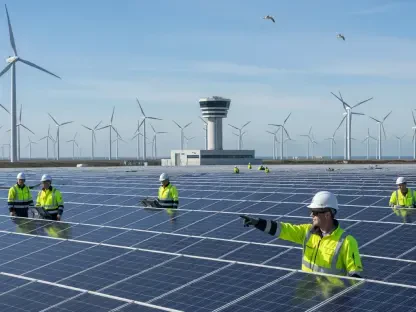The semiconductor industry stands as the invisible yet indispensable foundation of modern technology, driving everything from the smartphones in our pockets to the complex artificial intelligence (AI) systems reshaping industries. With projections estimating a market value surpassing $1 trillion by 2030, this sector is on the cusp of unprecedented growth, fueled by relentless innovation and escalating demand. Semiconductors are not just components; they are the enablers of a digital revolution that touches every aspect of life, from healthcare to transportation. This exploration delves into the pivotal trends and groundbreaking advancements that will define the trajectory of this industry over the next several years. By examining technological leaps, competitive dynamics, societal impacts, and geopolitical challenges, a comprehensive picture emerges of a field at a transformative crossroads. The stakes are high as nations, corporations, and innovators navigate a landscape marked by both opportunity and complexity, setting the stage for a future where semiconductors will play an even more critical role in shaping global progress.
Technological Breakthroughs
Transistor and Lithography Innovations
The relentless pursuit of smaller, faster, and more efficient chips is driving remarkable advancements in transistor design and lithography, crucial for meeting the demands of next-generation applications like AI and high-performance computing (HPC). Gate-All-Around (GAA) transistors represent a significant evolution from previous architectures, offering enhanced control over power leakage and performance at sub-3nm and sub-2nm nodes. This technology, adopted by industry leaders, allows for precise tuning to handle energy-intensive workloads, a necessity in an era where computational needs are skyrocketing. Simultaneously, High-Numerical Aperture (High-NA) Extreme Ultraviolet (EUV) lithography is pushing the boundaries of miniaturization with unparalleled resolution, enabling nearly triple the transistor density compared to current systems. This innovation reduces reliance on costly multi-patterning techniques, paving the way for more efficient production at advanced nodes, though its high cost remains a hurdle for widespread adoption.
Beyond transistor scaling, advanced packaging techniques are redefining how chips are designed and integrated, offering new pathways to performance gains. Methods like 3D stacking with Through-Silicon Vias (TSVs) and the use of chiplet architectures are gaining traction, allowing for modular designs that combine diverse components into compact, high-bandwidth systems. These approaches not only enhance power efficiency but also provide flexibility in addressing specific application needs, such as AI accelerators. High Bandwidth Memory (HBM) integration further supports this shift by shortening data travel distances, a critical factor for data-heavy tasks. As these packaging innovations become more mainstream, they are expected to play a pivotal role in sustaining the industry’s growth trajectory, especially as traditional scaling approaches physical limits. The convergence of these technologies signals a new era where efficiency and adaptability are paramount.
Novel Materials and Future Possibilities
As traditional silicon reaches its limits, the exploration of novel materials is opening up exciting possibilities for the future of semiconductor design, particularly in specialized applications. Gallium Nitride (GaN) and Silicon Carbide (SiC) are already making waves in power electronics, offering superior efficiency over silicon in areas like electric vehicles (EVs), 5G infrastructure, and renewable energy systems. These materials handle higher voltages and temperatures, making them ideal for demanding environments where energy conservation is critical. Their adoption is steadily increasing as industries seek to reduce energy loss and enhance performance, marking a significant shift in how power management chips are engineered. This transition is not just a technical upgrade but a response to broader societal needs for sustainability and efficiency in technology.
Looking further ahead, emerging 2D materials such as Molybdenum Disulfide (MoS2) and Indium Selenide (InSe) hold promise for ultra-thin, high-mobility transistors that could redefine low-power applications, especially for AI at the edge. These materials offer the potential to create chips with exceptional performance in incredibly small footprints, ideal for the compact devices of tomorrow. However, significant challenges remain in scaling these materials for mass production, as current manufacturing processes are not yet equipped to handle their unique properties at a commercial level. Research continues to address these hurdles, with the hope that breakthroughs in fabrication techniques will unlock their full potential. The journey from lab to market for these materials underscores the industry’s commitment to pushing beyond conventional boundaries, setting the stage for a post-silicon era.
AI and Semiconductors: A Symbiotic Bond
Driving Demand and Innovation
The relationship between AI and semiconductors is one of mutual reinforcement, where the exponential growth of AI applications drives an insatiable demand for advanced chips, while those chips, in turn, enable more sophisticated AI capabilities. Specialized hardware like Graphics Processing Units (GPUs) and Application-Specific Integrated Circuits (ASICs) are at the forefront of this dynamic, tailored to handle the massive computational loads of AI models, from data center training to real-time edge processing. This demand pushes semiconductor manufacturers to innovate rapidly, developing chips that offer higher throughput and energy efficiency to keep pace with AI’s evolving needs. As AI permeates industries from healthcare to automotive, the pressure on chip design intensifies, creating a cycle where each advancement in one field fuels progress in the other, reshaping technological landscapes.
Moreover, AI is not just a consumer of semiconductor technology but also a tool for its creation, transforming the very processes that build these chips. By integrating AI into manufacturing workflows, companies are optimizing design cycles, enhancing predictive maintenance, and accelerating material discovery. Machine learning algorithms can analyze vast datasets to identify inefficiencies or predict equipment failures before they occur, reducing downtime and costs. This self-reinforcing loop of innovation means that as AI improves chip production, the resulting chips further enhance AI capabilities, driving a virtuous cycle of advancement. Such integration is becoming a competitive edge for manufacturers, highlighting how deeply intertwined these two fields have become in pushing the boundaries of what technology can achieve.
Shaping Future Applications
The impact of AI-driven semiconductor advancements extends far beyond technical specifications, influencing a wide array of applications that promise to redefine everyday life by the end of the decade. In sectors like autonomous vehicles, chips optimized for AI are enabling real-time decision-making and sensor processing, crucial for safe navigation in complex environments. Similarly, in healthcare, AI-powered chips facilitate precision diagnostics and personalized treatments by processing vast amounts of medical data with unprecedented speed. These developments are not merely incremental but represent a leap toward smarter, more responsive systems that can adapt to human needs, showcasing the transformative potential of this technological synergy.
Additionally, the proliferation of edge AI—where processing happens on devices rather than centralized servers—relies heavily on compact, efficient semiconductors to bring intelligence directly to consumer gadgets and IoT ecosystems. This shift reduces latency and enhances data privacy by minimizing reliance on cloud connectivity, a critical consideration as connected devices multiply. However, it also places new demands on chip designers to balance power consumption with performance in constrained environments. As these edge applications grow, from smart home devices to industrial sensors, the semiconductor industry must continue to innovate, ensuring that AI’s benefits are accessible across diverse platforms. This trend underscores the broader societal implications of AI-semiconductor integration, pointing to a future where intelligence is embedded everywhere.
Corporate Competition and Market Dynamics
The Race for Supremacy
In the high-stakes arena of semiconductor manufacturing, a fierce competition among industry titans like TSMC, Samsung, and Intel is driving technological progress at a breakneck pace, with each vying for dominance in advanced process nodes. TSMC holds a commanding position as a pure-play foundry, excelling in GAA transistor technology and advanced packaging solutions that cater to a wide range of clients. Samsung, with its dual role as both an integrated device manufacturer and foundry, pushes forward with unique transistor designs like Multi-Bridge-Channel FET, while Intel aims to reclaim leadership through early adoption of cutting-edge lithography tools. The race to master sub-2nm processes is not just about technical superiority but also about securing market share in a landscape where AI and HPC applications demand ever-more-powerful chips, shaping the future of global tech ecosystems.
The financial implications of this competition are staggering, as the costs of research and development, coupled with the construction of new fabrication facilities, often run into tens of billions of dollars. Such capital intensity creates significant barriers to entry, potentially favoring larger players and leading to industry consolidation as smaller firms struggle to keep up. Equipment suppliers like ASML, which provides critical lithography systems, also play a pivotal role, benefiting from robust demand as foundries scale up. This dynamic raises questions about the long-term diversity of innovation, as the concentration of resources among a few giants might limit the variety of approaches to solving complex challenges. Monitoring how these competitive forces evolve will be essential to understanding the industry’s direction over the next several years.
Strategic Alliances and Market Shifts
Beyond individual corporate efforts, strategic alliances and partnerships are becoming increasingly vital in navigating the complexities of semiconductor advancement and market demands. Chip designers such as NVIDIA and AMD rely heavily on foundries like TSMC to produce cutting-edge AI hardware, fostering a collaborative ecosystem where innovation is shared across the supply chain. Tech giants including Google, Apple, and Amazon are also entering the fray by developing custom silicon tailored to their specific AI and cloud computing needs, reducing dependency on third-party solutions. These partnerships often involve sharing intellectual property and co-investing in new technologies, spreading the financial burden of innovation while accelerating time-to-market for critical components.
Furthermore, the competitive landscape is influencing broader market shifts, as companies position themselves to capture emerging opportunities in AI, IoT, and beyond. The push for vertical integration—where firms control more of the production process—reflects a strategic response to supply chain vulnerabilities and the need for greater control over quality and delivery timelines. At the same time, the high stakes of leading in advanced nodes like 2nm are prompting mergers and acquisitions as a means to pool resources and expertise. These market dynamics not only reshape corporate strategies but also impact global trade patterns, as the flow of technology and capital adapts to new competitive realities. The interplay of rivalry and collaboration in this space will likely define which entities emerge as leaders by the decade’s end.
Societal and Economic Impacts
Transformative Applications
Semiconductors are catalyzing profound societal changes by enabling groundbreaking applications across multiple sectors, with AI chips acting as a key driver of economic expansion and innovation. In healthcare, advanced chips power AI-driven diagnostic tools that analyze medical imaging and genetic data with remarkable accuracy, paving the way for personalized medicine and early disease detection. Similarly, in the automotive industry, semiconductors are the backbone of autonomous driving systems, processing vast streams of sensor data to ensure safety and efficiency on the roads. These developments are not just technological feats but also economic engines, creating new markets and opportunities for growth as industries adapt to smarter, more connected solutions by 2030.
However, alongside these transformative benefits come significant challenges, particularly around workforce displacement due to automation enabled by AI and semiconductor advancements. As machines take on more tasks in manufacturing, logistics, and even creative fields, there is a pressing need to reskill workers and adapt educational systems to prepare for a shifting job landscape. Governments and corporations must collaborate to address these transitions, ensuring that the economic gains from semiconductor-driven technologies are equitably distributed. The potential for job creation in emerging fields like AI system maintenance and data analysis offers hope, but proactive strategies are essential to mitigate disruption. This duality of opportunity and challenge underscores the broader societal impact of the semiconductor revolution.
Environmental Challenges
The environmental footprint of semiconductor manufacturing and AI workloads presents a critical challenge that the industry must confront to align with global sustainability goals. Producing advanced chips is resource-intensive, requiring vast amounts of water, energy, and rare materials, while the operation of AI systems, particularly in data centers, consumes significant electricity. This dual burden has sparked concern among environmental advocates and policymakers, pushing for a reevaluation of how chips are made and used. Efforts to reduce carbon emissions and minimize waste are gaining traction, as stakeholders recognize that unchecked growth could undermine the societal benefits of technological progress, necessitating a careful balance between innovation and responsibility.
In response, the industry is pivoting toward greener practices, with a focus on developing energy-efficient chip designs and sustainable manufacturing processes to address environmental concerns. Concepts like “green AI chips” aim to lower power consumption without sacrificing performance, while innovations in recycling and water reclamation are being integrated into production facilities. Collaborative initiatives between companies and governments are also emerging to set standards for environmental impact, encouraging the adoption of renewable energy sources in fabrication plants. These steps, though still in early stages, reflect a growing awareness that long-term success depends on harmonizing technological advancement with ecological stewardship. Addressing these environmental concerns will be crucial as the sector scales to meet rising demand over the coming years.
Geopolitical Stakes and Supply Chains
Strategic Importance and Vulnerabilities
Semiconductors have transcended their role as mere technological components to become strategic assets central to national security and economic stability, amplifying geopolitical tensions worldwide. The global supply chain for these chips is highly concentrated, with production often centered in specific regions like Taiwan, creating vulnerabilities to disruptions from geopolitical unrest or natural disasters. Such concentration has elevated semiconductors to a focal point in international relations, with nations imposing export controls and trade restrictions to safeguard their interests. This dynamic is evident in policies aimed at curbing the flow of advanced technology to certain countries, highlighting how deeply intertwined technology and politics have become in this arena.
Efforts to mitigate these risks are underway, as governments and companies push for greater supply chain resilience through diversification of manufacturing bases. Initiatives like the U.S. CHIPS Act underscore a global trend toward bolstering domestic production capabilities, reducing reliance on foreign sources, and securing technological sovereignty. However, building new fabrication facilities comes with immense costs, often in the range of billions of dollars, posing significant financial and logistical challenges. These efforts reflect a broader recognition that supply chain security is not just an economic issue but a matter of national importance, influencing how countries position themselves in the global tech race. The outcome of these strategies will likely reshape trade patterns and alliances in the years ahead.
Regional Diversification Efforts
The push for regional diversification in semiconductor production is gaining momentum as a direct response to the vulnerabilities exposed by a concentrated supply chain, prompting nations to invest heavily in localized capabilities. Countries across Europe, Asia, and North America are establishing incentives and funding programs to attract chip manufacturers, aiming to create a more balanced global network of production hubs. This shift is not merely about reducing risk but also about fostering economic growth and technological independence, as regions seek to cultivate their own expertise and infrastructure. The ambition is to ensure that no single area holds disproportionate control over a resource as critical as semiconductors, thereby enhancing stability in times of crisis.
Yet, the road to diversification is fraught with obstacles, including the scarcity of skilled labor and the enormous capital required to establish cutting-edge facilities that can compete with established players. Training a workforce capable of operating and innovating within these high-tech environments is a long-term endeavor, often spanning years, while the financial investment can deter smaller economies from fully participating. International collaboration is emerging as a potential solution, with alliances forming to share resources and knowledge, though such partnerships must navigate complex political landscapes. As these efforts unfold, their success will hinge on balancing immediate economic pressures with the strategic imperative to build a more resilient and equitable global semiconductor ecosystem by the decade’s close.
Future Outlook and Emerging Trends
Near-Term Milestones
As the semiconductor industry progresses toward 2030, several near-term milestones are set to shape its trajectory, particularly in the adoption of cutting-edge technologies to meet escalating demands. From now through 2026, technologies like GAA transistors and High-NA EUV lithography are expected to become standard in production lines, with major foundries ramping up capacity to support AI and HPC applications. These advancements will enable chips with greater efficiency and density, addressing the computational needs of increasingly complex systems. The focus on scaling these innovations rapidly reflects the urgency to stay ahead in a market where performance is a key differentiator, setting the stage for broader industry shifts in capability and competition.
Additionally, advanced packaging solutions, such as 3D stacking and High Bandwidth Memory (HBM), are poised to take on a more prominent role in chip design during this period. The surge in demand for HBM, driven by AI workloads, underscores the importance of integrating high-bandwidth solutions to handle massive data flows efficiently. Foundries and designers are prioritizing these techniques to create modular, adaptable systems that can cater to diverse applications without the prohibitive costs of monolithic designs. This transition not only enhances performance but also offers a pathway to cost savings, a critical consideration as investment in new technologies continues to soar. Tracking these milestones will provide insight into how quickly the industry can adapt to evolving technological and market pressures.
Long-Term Horizons
Looking further ahead, the exploration of novel materials and AI-driven manufacturing processes promises to unlock transformative possibilities for semiconductors, extending their impact into realms like autonomous systems, IoT, and quantum computing. Materials beyond traditional silicon, such as 2D compounds, could enable entirely new classes of devices with unprecedented efficiency, though scaling these for commercial use remains a significant challenge. Concurrently, AI’s integration into manufacturing is expected to revolutionize how chips are designed and produced, streamlining processes and uncovering innovative material combinations. These long-term prospects point to a future where the boundaries of technology are continually redrawn, offering solutions to some of the most pressing global challenges.
However, realizing these horizons will require overcoming substantial hurdles, including workforce shortages projected to reach critical levels by 2030, as the demand for skilled engineers and technicians outpaces supply. Addressing this gap necessitates investment in education and training programs tailored to the unique needs of semiconductor production, a task that demands coordination across public and private sectors. Additionally, the evolution of functional scaling—focusing on architectural innovations rather than mere size reduction—will be crucial as physical limits to miniaturization are approached. These strategies will shape how the industry sustains performance gains, ensuring that long-term growth remains viable amid technical and human resource constraints.
Sustainability and Innovation Balance
The imperative to balance sustainability with innovation is emerging as a defining challenge for the semiconductor industry, as environmental concerns gain prominence alongside technological progress. The energy-intensive nature of chip manufacturing and AI operations has prompted a push for greener practices, including the development of energy-efficient designs that minimize power consumption without compromising capability. Efforts to integrate renewable energy sources into production facilities are also underway, aiming to reduce the carbon footprint of an industry under increasing scrutiny. This focus on sustainability is not just a response to external pressures but a strategic move to ensure long-term viability in a world prioritizing ecological responsibility.
Achieving this balance, however, comes with its own set of complexities, particularly given the capital intensity of adopting sustainable technologies and building new facilities, often costing billions. The financial strain of such investments can challenge even the largest players, requiring innovative funding models and partnerships to distribute costs. Moreover, regulatory frameworks are evolving to enforce stricter environmental standards, adding another layer of compliance that must be navigated. As the industry strives to harmonize growth with responsibility, the success of these initiatives will depend on collaborative efforts to set and achieve ambitious yet realistic goals. The outcome will influence not only corporate strategies but also public perception of technology’s role in a sustainable future.
Global Dynamics and Policy Impacts
Geopolitical fragmentation and the drive for technological sovereignty are set to profoundly influence the semiconductor landscape, as nations prioritize domestic production to secure their economic and security interests. Policies aimed at reshoring manufacturing, such as significant legislative incentives, signal a global shift toward reducing reliance on concentrated supply chains. This trend is motivated by the recognition that semiconductors are critical to national infrastructure, from defense systems to economic competitiveness. The resulting diversification of production hubs could mitigate risks associated with geopolitical tensions, but it also introduces new complexities in coordinating a fragmented global market.
Monitoring the impact of these policy changes will be essential, as they are likely to reshape trade flows, investment patterns, and technological collaboration over the coming years. Export controls and international agreements on technology sharing will play a pivotal role in determining how innovation is distributed across borders, potentially creating disparities in access to cutting-edge advancements. At the same time, the interplay of corporate competition, technological breakthroughs, and global strategies will define the industry’s path toward 2030, with far-reaching implications for society and technology at large. Stakeholders must remain agile, adapting to these evolving dynamics.









